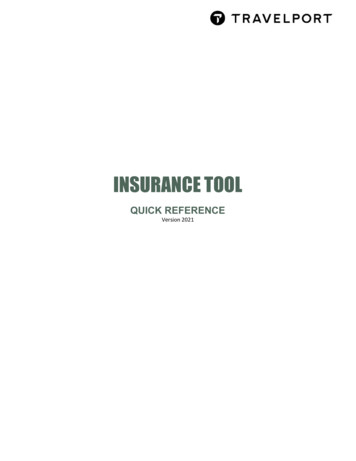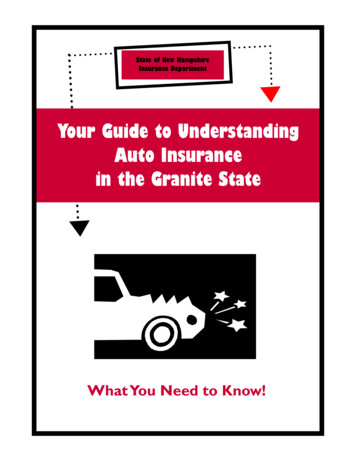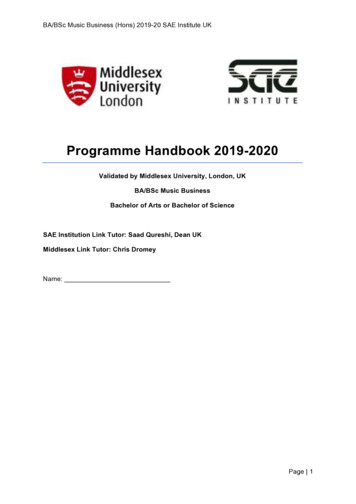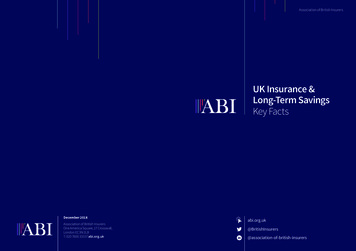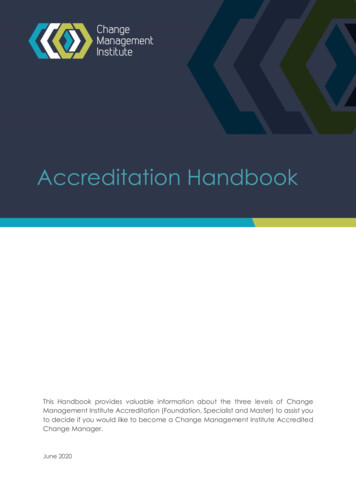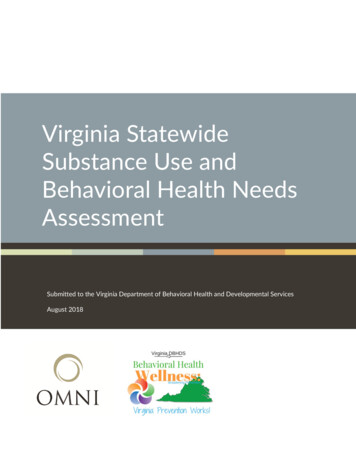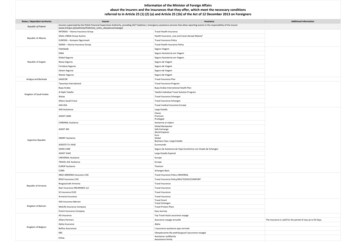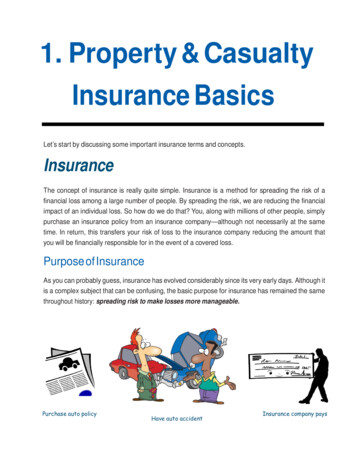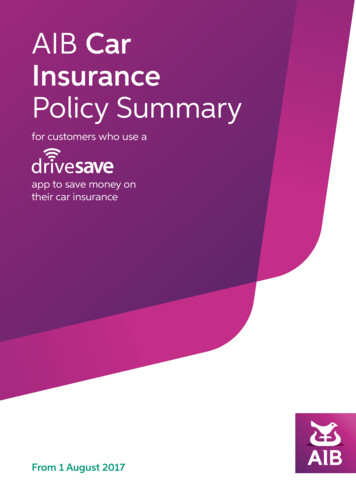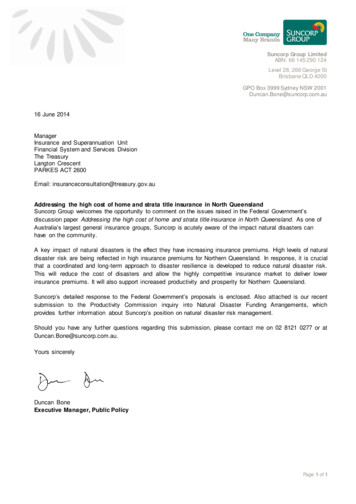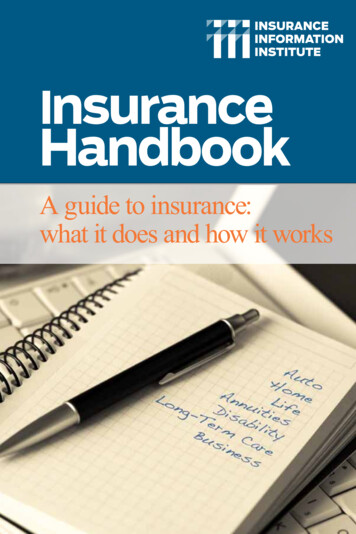
Transcription
InsuranceHandbookA guide to insurance:what it does and how it works
InsuranceHandbookA guide to insurance:what it does and how it works 2010 Insurance Information Institute. 978-0-932387-47-9
Insurance Information Institute110 William StreetNew York, NY 10038Tel. 212-346-5500. Fax. 212-732-1916. www.iii.orgPresident – Robert P. Hartwig, Ph.D., CPCU – bobh@iii.orgExecutive Vice President – Cary Schneider – carys@iii.orgSenior Vice President – Public Affairs – Jeanne Salvatore – jeannes@iii.orgSenior Vice President and Chief Economist – Steven N. Weisbart, Ph.D., CLU –stevenw@iii.orgResearchVice President – Global Issues – Claire Wilkinson – clairew@iii.orgPublicationsVice President – Publications and Information Services – Madine Singer –madines@iii.orgManaging Editor – Neil Liebman – neill@iii.orgResearch and Production – Mary-Anne Firneno – mary-annef@iii.orgDirector – Technology and Web Production – Shorna Lewis – shornal@iii.orgProduction Assistant – Katja Charlene Lewis – charlenel@iii.orgInformation Specialist – Alba Rosario – albar@iii.orgSpecial Consultant – Ruth Gastel, CPCU – ruthg@iii.orgMediaNew York:Vice President – Media Relations – Michael Barry – michaelb@iii.orgVice President – Web and Editorial Services – Andréa C. Basora –andreab@iii.orgVice President – Communications – Loretta Worters – lorettaw@iii.orgWeb/Media Producer – Justin Shaddix – justins@iii.orgWest Coast:Insurance Information Network of California:Executive Director – Candysse Miller – cmiller@iinc.orgTel. 213-624-4462. Fax. 213-624-4432.Northern California:Communications Specialist – Tully Lehman – tlehman@iinc.orgTel. 925-300-9570. Fax. 925-906-9321.RepresentativesDavis Communications – William J. Davis, Atlanta – billjoe@bellsouth.netTel. 770-321-5150. Fax. 770-321-5150.Hispanic Press Officer – Elianne González, Miami – elianneg@iii.orgTel. 954-389-9517.Florida Representative – Lynne McChristian, Tampa – lynnem@iii.orgTel. 813-480-6446. Fax. 813-915-3463.
InsuranceHandbookA guide to insurance:what it does and how it works 2010 Insurance Information Institu§te. 978-0-932387-47-9
To The ReaderFor over 50 years, the Insurance Information Institute (I.I.I.) has providedinformation to help consumers, reporters, insurance companies and researchersunderstand how insurance works and what it does. The Insurance Handbook isthe latest addition to I.I.I.’s vast arsenal of resources, including books, brochures,newsletters and videos.Long a primary source of information, analysis and referral on property/casualtyinsurance issues, the I.I.I. has broadened its reach over the years. Today, the I.I.I. is alsoa leading source for clear, comprehensive information on annuities, retirement andother life/health insurance concerns. The Insurance Handbook reflects this diversity ofsubjects and issues.The book begins with basic information on the various types of insurance,including auto, home, life, annuities and long-term care. A glossary section containsover 500 entries, including over 100 life insurance definitions provided by LOMA, aworldwide association of life and financial services companies. A directory lists a widerange of insurance organizations, including national, state and specialty associations.Issues briefs provide overviews of the trends and developments shaping the insuranceindustry from natural catastrophes to terrorism to workplace safety.The Handbook is designed to be used in conjunction with the Institute’s otherinformation resources: our Web site (www.iii.org), which provides comprehensiveinformation on all aspects of insurance, and our various publications, including theInsurance Fact Book, the Financial Services Fact Book and A Firm Foundation: HowInsurance Supports the Economy.Its scope and clarity make it an ideal source for a wide variety of audiences,including: Reporters Public policymakers Regulators Students Insurance company employees AcademicsWe believe this Handbook will prove a source of vital information to the mediaand others who have long relied on the I.I.I.’s spokespersons and resources forcreditable, timely information. We appreciate your comments.Robert Hartwig, Ph.D., CPCUPresidentInsurance Information Institute
ContentsInsurance Basics .1Overview1Auto Insurance3Homeowners Insurance5Business Insurance10Life Insurance16Annuities19Long-Term Care Insurance22Disability Insurance24Insurance Topics . 27Captives and Other Risk-Financing Options29Catastrophes: Insurance Issues32Cellphones and Driving34Climate Change: Insurance Issues35Credit Scoring39Earthquakes: Risk and Insurance Issues43Financial and Market Conditions45Flood Insurance47Insurance Fraud50The Liability System and Medical MalpracticeInsurance Issues52Microinsurance54No-Fault Auto Insurance and Other Auto Liability Systems 55Regulation57Reinsurance60Residual Markets62Terrorism Risk and Insurance69Workers Compensation73Glossary . 78Directories .128Property/Casualty Insurance Industry Organizations128Life/Health Insurance Industry Organizations132Financial Services Industry Organizations134Agents and Brokers141
Regulatory/Legislative Organizations142Educational Organizations143Specialty 6Alternative Markets146Auto/Auto Insurance146Automation and Claims Services147Aviation147Community Development147Crime/Fraud147Crop Insurance148Flood Insurance149International149Legal Issues and Services152Marine and Ground Transportation152Medical Malpractice/Professional Liability153Nuclear Insurance153Professional153Property Insurance Plans154Reinsurance154Risk Management154Safety/Disaster Mitigation155Surety, Financial Guaranty and Mortgage157Title Insurance158Weather158Workers Compensation158Research and Ratings Organizations159Alphabetical Index of Associations .162State Organizations .166Brief History .190I.I.I. Resources .193I.I.I. Member Companies .195I.I.I. Staff . Inside back cover
ancerusInscisaBOverviewThe insurance industry safeguards the assets of its policyholders by transferringrisk from an individual or business to an insurance company. Insurance companies act as financial intermediaries in that they invest the premiums they collectfor providing this service. Insurance company size is usually measured by netpremiums written, that is, premium revenues less amounts paid for reinsurance.There are three main insurance sectors: property/casualty, life/health and healthinsurance. Property/casualty (P/C) consists mainly of auto, home and commercial insurance. Life/health (L/H) consists mainly of life insurance and annuityproducts. Health insurance is offered by private health insurance companiesand some L/H and P/C insurers, as well as by government programs such asMedicare.RegulationAll types of insurance are regulated by the states, with each state having itsown set of statutes and rules. State insurance departments oversee insurer solvency, market conduct and, to a greater or lesser degree, review and rule onrequests for rate increases for coverage. The National Association of InsuranceCommissioners develops model rules and regulations for the industry, manyof which must be approved by state legislatures. The McCarran-Ferguson Act,passed by Congress in 1945, refers to continued state regulation of the insuranceindustry as being in the public interest. Under the 1999 Gramm-Leach-BlileyFinancial Services Modernization Act, insurance activities—whether conductedby banks, broker-dealers or insurers—are regulated by the states. However, therehave been, and continue to be, challenges to state regulation from some segments of the federal government as well as from some financial services firms.I.I.I. Insurance Handbook www.iii.org/insurancehandbook1
Insurance BasicsOverviewAccountingInsurers are required to use statutory accounting principles (SAP) when filingannual financial reports with state regulators and the Internal Revenue Service. SAP,which evolved to enhance the industry’s financial stability, is more conservativethan the generally accepted accounting principles (GAAP), established by the independent Financial Accounting Standards Board (FASB). The Securities and ExchangeCommission (SEC) requires publicly owned companies to report their financialresults using GAAP rules. Insurers outside the United States use standards that differ from SAP and GAAP. As global markets developed, the need for more uniformaccounting standards became clear. In 2001 the International Accounting StandardsBoard (IASB), an independent international accounting standards setting organization, began work on a set of standards, called International Financial ReportingStandards (IFRS) that it hopes will be used around the world. Since 2001 over 100countries have required or permitted the use of IFRS.In 2007 the SEC voted to stop requiring non-U.S. companies that use IFRSto re-issue their financial reports for U.S. investors using GAAP. In 2008 theNational Association of Insurance Commissioners began to explore ways tomove from statutory accounting principles to IFRS. Also in 2008, the FASB andIASB undertook a joint project to develop a common and improved frameworkfor financial reporting.DistributionProperty/casualty and life insurance policies were once sold almost exclusivelyby agents—either by captive agents, representing one insurance company, orby independent agents, representing several companies. Insurance companiesselling through captive agents and/or by mail, telephone or via the Internetare called “direct writers.” However, the distinctions between direct writers andindependent agency companies have been blurring since the 1990s, when insurers began to use multiple channels to reach potential customers. In addition, inthe 1980s banks began to explore the possibility of selling insurance throughindependent agents, usually buying agencies for that purpose. Other distribution channels include sales through professional organizations and throughworkplaces.2I.I.I. Insurance Handbook www.iii.org/insurancehandbook
Insurance BasicsAuto InsuranceAuto Insurance BasicsAuto insurance protects against financial loss in the event of an accident. It is acontract between the policyholder and the insurance company. The policyholder agrees to pay the premium and the insurance company agrees to pay losses asdefined in the policy.Auto insurance provides property, liability and medical coverage: Property coverage pays for damage to, or theft of, the car. Liability coverage pays for the policyholder’s legal responsibility toothers for bodily injury or property damage. Medical coverage pays for the cost of treating injuries, rehabilitationand sometimes lost wages and funeral expenses.Most states require drivers to have auto liability insurance before they can legally drive a car. (Liability insurance pays the other driver’s medical, car repair andother costs when the policyholder is at fault in an auto accident.) All states havelaws that set the minimum amounts of insurance or other financial securitydrivers have to pay for the harm caused by their negligence behind the wheel ifan accident occurs. Most auto policies are for six months to a year. A basic autoinsurance policy is comprised of six different kinds of coverage, each of which ispriced separately (see below).1. Bodily Injury LiabilityThis coverage applies to injuries that the policyholder and family members listed on the policy cause to someone else. These individuals are also covered whendriving other peoples’ cars with permission. As motorists in serious accidentsmay be sued for large amounts, drivers can opt to buy more than the staterequired minimum to protect personal assets such as homes and savings.2. Medical Payments or Personal Injury Protection (PIP)This coverage pays for the treatment of injuries to the driver and passengersof the policyholder’s car. At its broadest, PIP can cover medical payments,lost wages and the cost of replacing services normally performed by someoneinjured in an auto accident. It may also cover funeral costs.3. Property Damage LiabilityThis coverage pays for damage policyholders (or someone driving the car withtheir permission) may cause to someone else’s property. Usually, this meansdamage to someone else’s car, but it also includes damage to lamp posts, telephone poles, fences, buildings or other structures hit in an accident.I.I.I. Insurance Handbook www.iii.org/insurancehandbook3
Insurance BasicsAuto Insurance4. CollisionThis coverage pays for damage to the policyholder’s car resulting from a collision with another car, an object or as a result of flipping over. It also coversdamage caused by potholes. Collision coverage is generally sold with a deductible of 250 to 1,000—the higher the deductible, the lower the premium. Evenif policyholders are at fault for an accident, collision coverage will reimbursethem for the costs of repairing the car, minus the deductible. If the policyholderis not at fault, the insurance company may try to recover the amount it paidfrom the other driver’s insurance company, a process known as subrogation. Ifthe company is successful, policyholders will also be reimbursed for the deductible.5. ComprehensiveThis coverage reimburses for loss due to theft or damage caused by somethingother than a collision with another car or object, such as fire, falling objects,missiles, explosions, earthquakes, windstorms, hail, flood, vandalism and riots,or contact with animals such as birds or deer. Comprehensive insurance is usually sold with a 100 to 300 deductible, though policyholders may opt for ahigher deductible as a way of lowering their premium. Comprehensive insurance may also reimburse the policyholder if a windshield is cracked or shattered.Some companies offer separate glass coverage with or without a deductible.States do not require the purchase of collision or comprehensive coverage, butlenders may insist borrowers carry it until a car loan is paid off. It may also be arequirement of some dealerships if a car is leased.6. Uninsured and Underinsured Motorist CoverageUninsured motorist coverage will reimburse the policyholder, a member of thefamily or a designated driver if one of them is hit by an uninsured or a hit-andrun driver. Underinsured motorist coverage comes into play when an at-faultdriver has insufficient insurance to pay for the other driver’s total loss. This coverage will also protect a policyholder who is hit while a pedestrian.4I.I.I. Insurance Handbook www.iii.org/insurancehandbook
Insurance BasicsHomeowners InsuranceHomeowners Insurance BasicsHomeowners insurance provides financial protection against disasters. It is a package policy, which means that it covers both damage to property and liability, orlegal responsibility, for any injuries and property damage policyholders or theirfamilies cause to other people. This includes damage caused by household pets.Damage caused by most disasters is covered but there are exceptions. Standardhomeowners policies do not cover flooding, earthquakes or poor maintenance.Flood coverage, however, is available in the form of a separate policy both fromthe National Flood Insurance Program (NFIP) and from a few private insurers. Earthquake coverage is available either in the form of an endorsement oras a separate policy. Most maintenance-related problems are the homeowners’responsibility.A standard homeowners insurance policy includes four essential types ofcoverage. They include:1. Coverage for the Structure of the HomeThis part of a policy pays to repair or rebuild a home if it is damaged ordestroyed by fire, hurricane, hail, lightning or other disaster listed in the policy.It will not pay for damage caused by a flood, earthquake or routine wear andtear. Most standard policies also cover structures that are not attached to ahouse such as a garage, tool shed or gazebo. Generally, these structures are covered for about 10 percent of the total amount of insurance on the structure ofthe home.2. Coverage for Personal BelongingsFurniture, clothes, sports equipment and other personal items are covered ifthey are stolen or destroyed by fire, hurricane or other insured disaster. Mostcompanies provide coverage for 50 to 70 percent of the amount of insurance onthe structure of a home. This part of the policy includes off-premises coverage.This means that belongings are covered anywhere in the world, unless the policyholder has decided against off-premises coverage. Expensive items like jewelry,furs and silverware are covered, but there are usually dollar limits if they are stolen. To insure these items to their full value, individuals can purchase a specialpersonal property endorsement or floater and insure the item for its appraisedvalue.Trees, plants and shrubs are also covered under standard homeowners insurance—generally up to about 500 per item. Perils covered are theft, fire, lightning, explosion, vandalism, riot and even falling aircraft. They are not coveredfor damage by wind or disease.I.I.I. Insurance Handbook www.iii.org/insurancehandbook5
Insurance BasicsHomeowners Insurance3. Liability ProtectionLiability coverage protects against the cost of lawsuits for bodily injury or property damage that policyholders or family members cause to other people. It alsopays for damage caused by pets. The liability portion of the policy pays for boththe cost of defending the policyholder in court and any court awards—up to thelimit of the policy. Coverage is not just in the home but extends to anywherein the world. Liability limits generally start at about 100,000. However, expertsrecommend that homeowners purchase at least 300,000 worth of protection.An umbrella or excess liability policy, which provides broader coverage, including claims for libel and slander, as well as higher liability limits, can be added tothe policy. Generally, umbrella policies cost between 200 to 350 for 1 million of additional liability protection.Homeowners policies also provide no-fault medical coverage. In the eventthat someone is injured in a policyholder’s home, the injured person can simply submit medical bills to the policyholder’s insurance company. In this wayexpenses are paid without a liability claim being filed. This coverage, however,does not pay the medical bills for the policyholder’s own family or pets.4. Additional Living ExpensesThis pays the additional costs of living away from home if a house is inhabitable due to damage from a fire, storm or other insured disaster. It covers hotelbills, restaurant meals and other extra living expenses incurred while the homeis being rebuilt. Coverage for additional living expenses differs from company tocompany. Many policies provide coverage for about 20 percent of the insuranceon a house. The coverage can be increased for an additional premium. Somecompanies sell a policy that provides an unlimited amount of loss-of-use coverage, but for a limited amount of time.Additional living expense coverage also reimburses homeowners who rentout part of their home for the rent that would have been collected from a tenant if the home had not been destroyed.Types of Homeowners Insurance PoliciesThere are several types of homeowners insurance policies that differ in the amountof insurance coverage they provide. The different types are fairly standard throughout the country. However, individual states and companies may offer policies thatare slightly different or go by other names such as “standard” or “deluxe.” Peoplewho rent the homes they live in have specific renters policies.6I.I.I. Insurance Handbook www.iii.org/insurancehandbook
Insurance BasicsHomeowners InsuranceThe various types of homeowners insurance policies are listed below. HO-3: This is the most common policy and protects the home from allperils except those specifically excluded. HO-1: Limited coverage policyThis “bare bones” policy provides coverage against the first 10 disasters. It isno longer available in most states. HO-2: Basic policyA basic policy provides protection against all 16 disasters. There is a versionof HO-2 designed for mobile homes. HO-8: Older homeDesigned for older homes, this policy usually reimburses for damage on anactual cash value basis, which means replacement cost less depreciation. Fullreplacement cost policies may not be available for some older homes. HO4: RenterCreated specifically for people who rent the home they live in, this policyprotects personal possessions and any parts of the apartment that thepolicyholder owns, such as newly installed kitchen cabinets, against all 16disasters. H0-6: Condo/Co-opA policy for people who own a condo or co-op, it provides coverage forbelongings and the structural parts of the building that they own. It protectsagainst all 16 disasters.What Type of Disasters Are Covered?Most homeowners policies cover the 16 disasters listed below. Some “bare bones”policies only cover the first 10: Fire or lightning Windstorm or hail Explosion Riot or civil commotion Damage caused by aircraft Damage caused by vehiclesI.I.I. Insurance Handbook www.iii.org/insurancehandbook7
Insurance BasicsHomeowners Insurance Smoke Vandalism or malicious mischief Theft Volcanic eruption Falling object Weight of ice, snow or sleet Accidental discharge or overflow of water or steam from within a plumbing,heating, air conditioning, or automatic fire-protective sprinkler system, orfrom a household appliance Sudden and accidental tearing apart, cracking, burning, or bulging of asteam or hot water heating system, an air conditioning or automatic fireprotective system Freezing of a plumbing, heating, air conditioning or automatic, fireprotective sprinkler system, or of a household appliance Sudden and accidental damage from artificially generated electrical current(does not include loss to a tube, transistor or similar electronic component)Standard Homeowners Policy ExclusionsStandard homeowners policies exclude coverage for flood, earthquake, war,nuclear accident, landslide, mudslide, sinkhole. Some of these exclusions arediscussed below.1. FloodsFlood damage is excluded under standard homeowners and renters insurance policies. Flood coverage, however, is available in the form of a separate policy bothfrom the National Flood Insurance Program (NFIP) and from a few private insurers.Additional information on flood insurance can be found on the FloodSmart.govWeb site or by calling 888-379-9531. For coverage over and above the 250,000limit for property and 100,000 for contents provided by the NFIP, excess floodinsurance is available from private insurance companies. (See Topic on FloodInsurance on page 47 for further information.)Tsunamis cause flood damage and are therefore only covered by a flood policy.2. EarthquakesEarthquake coverage can be a separate policy or an endorsement to a homeowners or renters policy. It is available from most insurance companies. In8I.I.I. Insurance Handbook www.iii.org/insurancehandbook
Insurance BasicsHomeowners InsuranceCalifornia, it is also available from the California Earthquake Authority, a privately funded, publically managed organization. In earthquake prone states likeCalifornia, the policy comes with a high deductible.3. Damage Resulting from “Faulty, Defective or Inadequate” Maintenance,Workmanship, Construction or MaterialsDefective products can include construction materials. An insurance policy willnot cover damage due to lack of maintenance, mold, termite infestation andinfestation from other pests. It is the policyholder’s responsibility to take reasonable precautions to protect the home from damage.Levels of CoverageThere are three coverage options.1. Actual Cash ValueThis type of coverage pays to replace the home or possessions minus a deduction for depreciation.2. Replacement CostThis type of coverage pays the cost of rebuilding or repairing the home orreplacing possessions without a deduction for depreciation.3. Guaranteed/Extended Replacement CostAn extended replacement cost policy pays a certain percentage, generally 20-25percent, over the coverage limit to rebuild the home in the event that materialsand labor costs are pushed up by a widespread disaster, for example. For example, if homeowners take out a policy for 100,000, they can get up to an extra 20,000 or 25,000 of coverage.Some companies offer a guaranteed replacement cost policy, which payswhatever it costs to rebuild the home as it was before the fire or other disaster,even if it exceeds the policy limit. This gives protection against sudden increasesin construction costs due to a shortage of building materials after a widespreaddisaster or other unexpected situations. It generally does not cover the costof upgrading the house to comply with current building codes. However, anendorsement (or an addition to) the policy called Ordinance or Law can helppay for these additional costs.Guaranteed and extended replacement cost policies are more expensive; butcan offer excellent financial protection against disasters. This type of coverage,however, may not be available in all states or from all companies.I.I.I. Insurance Handbook www.iii.org/insurancehandbook9
Insurance BasicsBusiness InsuranceBusiness Insurance BasicsMost businesses need to purchase at least the following four types of insurance:1. Property InsuranceProperty insurance compensates a business if the property used in the businessis lost or damaged as the result of various types of common perils, such as fireor theft. Property insurance covers not just a building or structure but also thecontents, including office furnishings, inventory, raw materials, machinery,computers and other items vital to a business’s operations. Depending on thetype of policy, property insurance may include coverage for equipment breakdown, removal of debris after a fire or other destructive event, some types ofwater damage and other losses.Business Interruption InsuranceAlso known as business income insurance, business interruption insurance isa type of property insurance. A business whose property has sustained a directphysical loss such as fire damage or a damaged roof due to a tree falling on itin a windstorm and has to close down completely while the premises are beingrepaired may lose out to competitors. A quick resumption of business after adisaster is essential. That is why business interruption insurance is so important.There are typically three types of business interruption insurance. A businesscan purchase any one or combination of these. Business Income Coverage: Compensates for lost income if a companyhas to vacate its premises due to disaster-related damage that is coveredunder the property insurance policy. Business income insurance covers theprofits the company would have earned, based on financial records, hadthe disaster not occurred. The policy also covers operating expenses, suchas electricity, that continue even though business activities have come to atemporary halt. Extra Income Coverage: Reimburses the company for a reasonable sum ofmoney that it spends, over and above normal operating expenses, to avoidhaving to shut down during the restoration period. Contingent Business Interruption Insurance: Protects a businessowner’searnings following physical loss or damage to the property of the insured’ssuppliers or customers, as opposed to its own property.Damage due to floods, earthquakes and acts of terrorism are generally notcovered by standard business property insurance but can be purchased throughvarious markets.10I.I.I. Insurance Handbook www.iii.org/insurancehandbook
Insurance BasicsBusiness InsuranceProtection Against Flood DamageProperty insurance policies usually exclude coverage for flood damage.Businesses should find out from their local government office or commercialbank whether their business is located in a flood zone and whether their location has been flooded in the past. Flood insurance is available through the federal government’s National Flood Insurance Program (www.FloodSmart.gov),which is serviced by private carriers, and from a few specialty insurers.Protection Against Earthquake DamageCoverage for earthquake damage is excluded in most property insurance policies, including businessowners package policies. Businesses in an earthquakeprone area will need a special earthquake insurance policy or commercial property earthquake endorsement.Protection Against Terrorist Attack LossesUnder the Terrorism Risk Insurance Act of 2002 and its extensions, only businesses that purchase optional terrorism coverage are covered for losses arisingfrom terrorist acts. The exception is workers compensation, which covers workrelated injuries and deaths including those due to acts of terrorism.2. Liability InsuranceAny enterprise can be sued. Customers may claim that the business caused themharm as the result of, for example, a defective product, an error in a service ordisregard for another person’s property. Or a claimant may allege that the business created a hazardous environment. Liability insurance pays damages forwhich the business is found liable, up to the policy limits, as well as attorneys’fees and other legal defense expenses. It also pays the medical bills of any people injured by, or on the premi
Insurance Information Institute 110 William Street New York, NY 10038 Tel. 212-346-5500. Fax. 212-732-1916. www.iii.org President – Robert P. Hartwig, Ph.D., CPCU – bobh@iii.org Executive Vice President – Cary Schneider – carys@iii.org Senior Vice President – Public Affairs – Jeanne Salvatore – jeannes@iii.org Senior V
